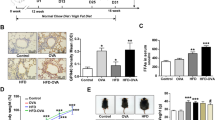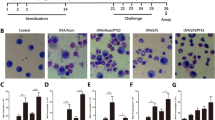Abstract
Peroxisome proliferator-activated receptor-γ (PPARγ) agonist pioglitazone (PGZ) exhibits potential protective effects in asthma. Recently, regulator of G protein 4 (RGS4) has been reported to be associated with immunological and inflammatory responses. However, no evidence has shown the influence of PPARγ on RGS4 expression in airway disorders. In this study, BALB/c mice received ovalbumin (OVA) sensitization followed by OVA intranasal challenge for 90 days to establish a chronic asthma mouse model. Accompanied with OVA challenge, the mice received administration of PPARγ agonist PGZ (10 mg/kg) intragastrically or RGS4 inhibitor CCG 63802 (0.5 mg/kg) intratracheally. Invasive pulmonary function tests were performed 24 h after last challenge. Serum, bronchoalveolar lavage fluid (BALF), and lung tissues were collected for further analyses after the mice were sacrificed. We found that PPARγ agonist PGZ administration significantly attenuated the pathophysiological features of OVA-induced asthma and increased the expression of RGS4. In addition, the attenuating effect of PGZ on airway inflammation, hyperresponsiveness (AHR), and remodeling was partially abrogated by administration of RGS4 inhibitor CCG 63802. We also found that the downregulation of RGS4 by CCG 63802 also significantly increased inflammatory cell accumulation and AHR, and increased levels of IL-4, IL-13, eotaxin, IFN-γ, and IL-17A in BALF, and total and OV-specific IgE in serum. Furthermore, the inhibitory effects of PGZ on the activations of ERK and Akt/mTOR signaling, and MMPs were apparently reversed by CCG 63802 administration. In conclusion, the protective effect of PGZ on OVA-induced airway inflammation and remodeling might be partly regulated by RGS4 expression through ERK and Akt/mTOR signaling.






Similar content being viewed by others
References
Fahy, J.V. 2015. Type 2 inflammation in asthma—present in most, absent in many. Nature Reviews. Immunology 15 (1): 57–65.
Barnig, C., and B.D. Levy. 2015. Innate immunity is a key factor for the resolution of inflammation in asthma. European Respiratory Review 24 (135): 141–153.
Dunican, E.M., and J.V. Fahy. 2015. The role of type 2 inflammation in the pathogenesis of asthma exacerbations. Annals of the American Thoracic Society 2 (1): S144–S149.
Khan, M.A., A.M. Assiri, and D.C. Broering. 2015. Complement mediators: key regulators of airway tissue remodeling in asthma. Journal of Translational Medicine 13 (1): 272.
Berger, J., and D.E. Moller. 2002. The mechanisms of action of PPARs. Annual Review of Medicine 53 (1): 409–435.
Rizzo, G., and S. Fiorucci. 2006. PPARs and other nuclear receptors in inflammation. Current Opinion in Pharmacology 6 (4): 421–427.
Liu, H.J., H.H. Liao, Z. Yang, and Q.Z. Tang. 2016. Peroxisome proliferator-activated receptor-gamma is critical to cardiac fibrosis. PPAR Research 2016 (1): 2198645.
Grygiel-Gorniak, B. 2014. Peroxisome proliferator-activated receptors and their ligands: nutritional and clinical implications—a review. Nutrition Journal 13 (1): 17.
Reka, A.K., M.T. Goswami, Rashmi Krishnapuram, Theodore J. Standiford, and V.G. Keshamouni. 2011. Molecular cross-regulation between PPAR-gamma and other signaling pathways: implications for lung cancer therapy. Lung Cancer 72 (2): 154–159.
Druey, K.M. 2009. Regulation of G-protein-coupled signaling pathways in allergic inflammation. Immunologic Research 43 (1–3): 62–76.
Xie, Z., E.C. Chan, and K.M. Druey. 2016. R4 regulator of G protein signaling (RGS) proteins in inflammation and immunity. The AAPS Journal 18 (2): 294–304.
Sprang, S.R. 2016. Invited review: activation of G proteins by GTP and the mechanism of Galpha-catalyzed GTP hydrolysis. Biopolymers 105 (8): 449–462.
Bansal, G., K.M. Druey, and Z. Xie. 2007. R4 RGS proteins: regulation of G-protein signaling and beyond. Pharmacology & Therapeutics 116 (3): 473–495.
Kao, H.F., P.W. Chang-Chien, Wen Tsan Chang, T.M. Yeh, and J.Y. Wang. 2013. Propolis inhibits TGF-beta1-induced epithelial-mesenchymal transition in human alveolar epithelial cells via PPARgamma activation. International Immunopharmacology 15 (3): 565–574.
Takata, Y., J. Liu, Fen Yin, Alan R. Collins, Christopher J. Lyon, Chih Hao Lee, Annette R. Atkins, et al. 2008. PPARdelta-mediated antiinflammatory mechanisms inhibit angiotensin II-accelerated atherosclerosis. Proceedings of the National Academy of Sciences of the United States of America 105 (11): 4277–4282.
Fang, P., L. Zhou, Y. Zhou, J.K. Kolls, T. Zheng, and Z. Zhu. 2014. Immune modulatory effects of IL-22 on allergen-induced pulmonary inflammation. PLoS One 9 (9): e107454.
Sumi, Y., and Q. Hamid. 2007. Airway remodeling in asthma. Allergology International 56 (4): 341–348.
Sauer, S. 2015. Ligands for the nuclear peroxisome proliferator-activated receptor gamma. Trends in Pharmacological Sciences 36 (10): 688–704.
Kinouchi, T., K.T. Kitazato, Kenji Shimada, Kenji Yagi, Yoshiteru Tada, Nobuhisa Matsushita, Manabu Sumiyoshi, Junichiro Satomi, Teruyoshi Kageji, and S. Nagahiro. 2012. Activation of signal transducer and activator of transcription-3 by a peroxisome proliferator-activated receptor gamma agonist contributes to neuroprotection in the peri-infarct region after ischemia in oophorectomized rats. Stroke 43 (2): 478–483.
Park, S.J., K.S. Lee, So Ri Kim, Kyung Hoon Min, Yeong Hun Choe, Hee Moon, Han Jung Chae, Wan Hee Yoo, and Y.C. Lee. 2009. Peroxisome proliferator-activated receptor gamma agonist down-regulates IL-17 expression in a murine model of allergic airway inflammation. Journal of Immunology 183 (5): 3259–3267.
Damera, G., K.M. Druey, Philip R. Cooper, Vera P. Krymskaya, Roy J. Soberman, Yassine Amrani, Toshinori Hoshi, Christopher E. Brightling, and R.A. Panettieri Jr. 2012. An RGS4-mediated phenotypic switch of bronchial smooth muscle cells promotes fixed airway obstruction in asthma. PLoS One 7 (1): e28504.
Harris, I.S., I. Treskov, M.W. Rowley, S. Heximer, K. Kaltenbronn, B.N. Finck, R.W. Gross, D.P. Kelly, K.J. Blumer, and A.J. Muslin. 2004. G-protein signaling participates in the development of diabetic cardiomyopathy. Diabetes 53 (12): 3082–3090.
Albig, A.R., and W.P. Schiemann. 2005. Identification and characterization of regulator of G protein signaling 4 (RGS4) as a novel inhibitor of tubulogenesis: RGS4 inhibits mitogen-activated protein kinases and vascular endothelial growth factor signaling. Molecular Biology of the Cell 16 (2): 609–625.
Blazer, L.L., D.L. Roman, Alfred Chung, Martha J. Larsen, Benjamin M. Greedy, Stephen M. Husbands, and R.R. Neubig. 2010. Reversible, allosteric small-molecule inhibitors of regulator of G protein signaling proteins. Molecular Pharmacology 78 (3): 524–533.
Bosier, B., P.J. Doyen, A. Brolet, G.G. Muccioli, E. Ahmed, N. Desmet, E. Hermans, and R. Deumens. 2015. Inhibition of the regulator of G protein signalling RGS4 in the spinal cord decreases neuropathic hyperalgesia and restores cannabinoid CB1 receptor signalling. British Journal of Pharmacology 172 (22): 5333–5346.
Asati, V., D.K. Mahapatra, and S.K. Bharti. 2016. PI3K/Akt/mTOR and Ras/Raf/MEK/ERK signaling pathways inhibitors as anticancer agents: structural and pharmacological perspectives. European Journal of Medicinal Chemistry 109 (1): 314–341.
Anger, T., N. Klintworth, Christian Stumpf, Werner G. Daniel, Ulrike Mende, and C.D. Garlichs. 2007. RGS protein specificity towards Gq- and Gi/o-mediated ERK 1/2 and Akt activation, in vitro. Journal of Biochemistry and Molecular Biology 40 (6): 899–910.
Hu, W., F. Li, Sunila Mahavadi, and K.S. Murthy. 2009. Upregulation of RGS4 expression by IL-1beta in colonic smooth muscle is enhanced by ERK1/2 and p38 MAPK and inhibited by the PI3K/Akt/GSK3beta pathway. American Journal of Physiology. Cell Physiology 296 (6): C1310–C1320.
Yamauchi, K., and H. Inoue. 2007. Airway remodeling in asthma and irreversible airflow limitation-ECM deposition in airway and possible therapy for remodeling. Allergology International 56 (4): 321–329.
Arpino, V., M. Brock, and S.E. Gill. 2015. The role of TIMPs in regulation of extracellular matrix proteolysis. Matrix Biology 44-46: 247–254.
Druey, K.M. 2003. Regulators of G protein signaling: potential targets for treatment of allergic inflammatory diseases such as asthma. Expert Opinion on Therapeutic Targets 7 (4): 475–484.
Funding
This work was funded by the Natural Science Foundation of China (No. 81000009), the Fundamental Research Funds for the Central Universities (2012jdhz15), and the Research Funds for the second affiliated hospital (RC (XM) 201101).
Author information
Authors and Affiliations
Corresponding author
Ethics declarations
Ethical Approval
All procedures performed in studies involving animals were in accordance with the Animal Research Ethics Committee of Xi’an Jiaotong University.
Conflict of Interest
The authors declare that they have no conflict of interest.
Rights and permissions
About this article
Cite this article
Meng, X., Sun, X., Zhang, Y. et al. PPARγ Agonist PGZ Attenuates OVA-Induced Airway Inflammation and Airway Remodeling via RGS4 Signaling in Mouse Model. Inflammation 41, 2079–2089 (2018). https://doi.org/10.1007/s10753-018-0851-2
Published:
Issue Date:
DOI: https://doi.org/10.1007/s10753-018-0851-2




